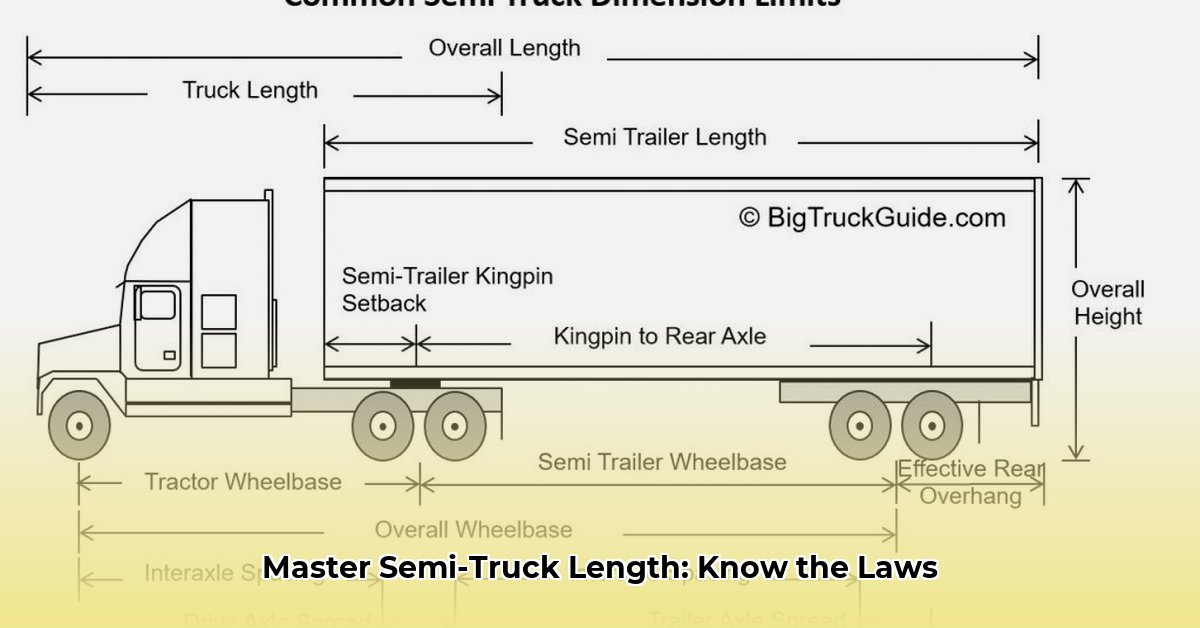
Understanding Semi-Truck Length: A Comprehensive Guide
Determining the precise length of a semi-truck isn't simply a matter of stating an average; it requires a nuanced understanding of various factors influencing overall dimensions and adherence to complex regulations. This guide provides a detailed breakdown, empowering fleet operators, drivers, regulators, and manufacturers to navigate the complexities of semi-truck length and ensure compliance. Did you know that variations in tractor and trailer combinations can significantly impact overall length? This has major implications for both safety and legality. For more on GVWR, see this helpful resource: GVWR information.
Average Dimensions: A Baseline, Not a Mandate
While a common estimate for a semi-truck and trailer combination is 70-72 feet long, 8.5 feet wide, and 13.5 feet high, these figures are merely approximations. Actual dimensions can vary considerably due to several key factors. For example, the length of the tractor itself can differ depending on whether it's a day cab or a sleeper cab. Furthermore, the type of trailer used (dry van, flatbed, tanker, etc.) heavily influences the overall length.
The Impact of Tractor and Trailer Configurations
The specific combination of tractor (the truck itself) and trailer significantly affects the overall length. A long-nose tractor coupled with a standard 53-foot dry van trailer will obviously be longer than a shorter tractor pulling a shorter flatbed trailer. This variability highlights the need for precise measurements and careful consideration of specific configurations.
Navigating State-Specific Regulations and Exceptions
Beyond the basic dimensions, a critical element is understanding that regulations regarding semi-truck lengths differ significantly from state to state. Some states may permit longer trailers than others, creating a complex regulatory landscape that requires thorough knowledge and careful planning. Moreover, older trucks may fall under different length regulations than newer models due to variations in historical standards. Factors such as the length of side mirrors and handholds also contribute to the overall dimensions and must remain within legal limits. Exceeding these limits necessitates obtaining special permits, adding to administrative burdens and costs.
Weight Distribution: A Critical Safety and Legal Aspect
The maximum legal weight for a fully loaded semi-truck, typically 80,000 pounds, is another crucial parameter. However, the way this weight is distributed between the tractor and trailer is critically important for safety and compliance. Poorly distributed weight can affect handling, stability, and even cause dangerous situations. Understanding and calculating weight distribution involves considering the weight of the truck, trailer, and cargo separately, which often requires precise calculations.
Practical Guide to Compliance
To ensure safe and legal operation, follow these steps:
Comprehensive Knowledge of Regulations: Familiarize yourself thoroughly with both federal and state-specific regulations concerning truck and trailer dimensions and weight limits. This requires diligent research and regular updates to account for changes in legislation.
Regular and Accurate Measurement: Employ reliable measuring tools to regularly verify that your truck and trailer combination adheres to all relevant regulations. Proactive measurement prevents costly violations and potential accidents.
Leverage Technological Tools: Utilize route planning software designed to account for size and weight restrictions. These tools optimize routes, minimizing delays and potential conflicts with regulations. This proactive approach helps prevent costly mistakes.
Invest in Driver Training: Equip your drivers with comprehensive training on weight distribution, dimensional limits, and state-specific regulations. Thorough training is vital for maintaining safety and compliance.
Stakeholder Responsibilities: Shared Commitment to Safety and Compliance
| Stakeholder | Immediate Actions | Long-Term Strategies |
|---|---|---|
| Fleet Operators | Implement rigorous pre-trip inspections, driver training programs | Invest in advanced route-planning software, continuously monitor legislative updates |
| Truck Drivers | Adhere strictly to regulations, maintain accurate logs | Participate in ongoing professional development, utilize available technological tools |
| Regulators | Enhance communication and data transparency | Advocate for uniform national standards, invest in real-time monitoring technologies |
| Manufacturers | Design trailers that optimize weight distribution and legal compliance | Utilize lightweight materials and advanced designs to improve efficiency and safety |
Key Takeaways:
- Precise knowledge of semi-truck dimensions is crucial for legal and safe operation.
- State-specific regulations create a complex landscape requiring detailed understanding.
- Proper weight distribution is essential for safety, efficiency, and compliance.
This guide provides a foundation for navigating the complexities of semi-truck length regulations. Staying informed and proactive is essential for the ongoing safety and efficiency of the trucking industry. By understanding and adhering to these guidelines, all stakeholders can contribute to a safer and more efficient transportation system.